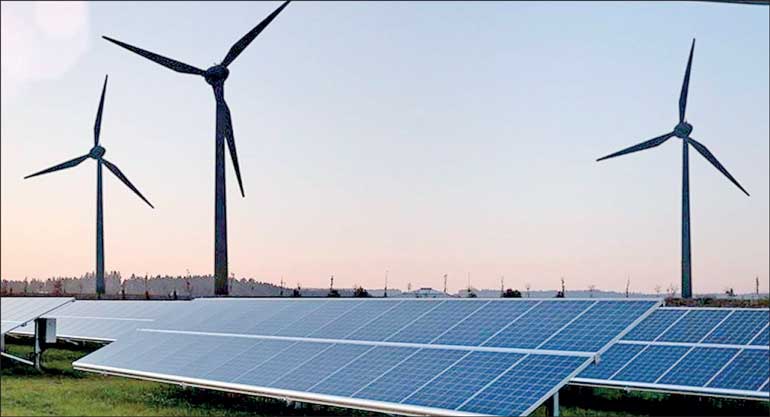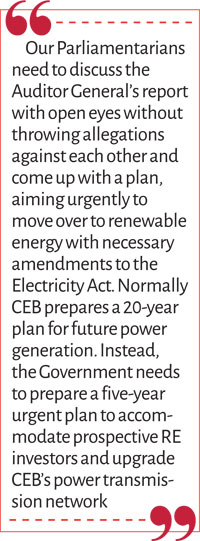Monday Apr 21, 2025
Monday Apr 21, 2025
Wednesday, 23 March 2022 00:20 - - {{hitsCtrl.values.hits}}


The world is facing a major oil and gas crisis. When corona infections affected the entire world, oil, gas and coal consumption and demand went down, lowering prices. In April 2020, with an unprecedented global energy glut, American oil producers paid buyers to remove produced oil stocks as they were unable to stop production. If our Trincomalee oil tanks were able to store oil, the country would have made lots of Dollars by storing cheap oil. In addition, Trincomalee harbour would have offered parking space for oil-laden ships. By the end of the corona pandemic all oil companies had made huge losses.
and coal consumption and demand went down, lowering prices. In April 2020, with an unprecedented global energy glut, American oil producers paid buyers to remove produced oil stocks as they were unable to stop production. If our Trincomalee oil tanks were able to store oil, the country would have made lots of Dollars by storing cheap oil. In addition, Trincomalee harbour would have offered parking space for oil-laden ships. By the end of the corona pandemic all oil companies had made huge losses.
After the corona threat receded, the world is recovering, also the oil, gas and coal prices, with oil and gas companies attempting to recover their losses. Now, with the Ukraine-Russia war, Western countries are attempting to boycott Russian oil, fuel prices are moving up threatening to reach the highest prices ever.
Impact on Sri Lanka
The country was already hampered by foreign exchange shortages, the higher oil prices restricted oil imports to run power generation plants resulting in up to eight-hour power-cuts.
The country’s maximum power requirement is around 2,750 MW. The country received heavy rainfall during 2021 and most hydro-power reservoirs were full till November end. The stored water was expected to meet the power demand during the poor rainy period from mid-January till April.
In early December, a power unit in Norochcholai power-plant capable of generating 300 MW of power broke down for over a month and hydro-power filled the gap, while consuming a large quantity of stored water. The reason for the breakdown of the Norochcholai power plant and the long delay in repairing it was never explained to the public. But there were rumours that the country had fallen behind payments to Chinese staff employed in operation of the power plant.
Obstructions to Renewable Energy
Part of the current power shortage could have been averted if solar power projects started in 2010 and wind power projects commenced in 2012 were allowed to continue. CEB stopped wind power projects in 2014 and acceptance of all Renewable Energy projects from 1 January 2017, claiming various issues. CEB’s obstructions were fought by the investors, but failed to achieve any positive results. The investors’ appeals to various ministers fell on deaf ears.
There had been a number of articles in newspapers on the need to implement RE projects. My article in Daily FT “Prominence to Renewable Energy would have averted electricity crisis” on 2022.01.31 detailed how CEB engineers obstructed RE development.
Auditor General’s report
Meanwhile, the Auditor General’s Department having evaluated the performance of the licensing process of proposed renewable energy power projects, the AG has submitted his report, but is waiting in line to be presented to the Parliament. Parts of the report and comments have appeared in various media, but the politicians and officials seem to be blind to the impending calamity.
According to the AG’s report, a total of 1,374 renewable energy projects approved by the Sustainable Energy Authority, capable of producing 4,014.44 MW are awaiting acceptance by CEB for implementation, who would purchase power from the producers and distribute the electricity to the public (refer given table).
Thus, when Private Power Producers (PPPs) were prepared to invest their own funds to produce electricity amounting to over 4,000 MW, the country failed to fulfil a demand of 2,750 MW. If one fourth of PPPs were allowed, the current power shortage could have been averted.
 Power costs
Power costs
When solar and wind power were proposed, solar investors were offered Rs. 22 per unit at the beginning (later lowered to Rs. 16.50). But CEB engineers claimed coal-based power was cheapest around Rs. 12 a unit, but they conveniently forgot the loan instalments paid by the Treasury.
But today, with rising oil and coal spot prices, electricity costs from oil will easily cross Rs. 35 a unit. The last spot tender for coal was at $ 270/ton delivered to Norochcholai, resulting in coal-based power costing Rs. 30 a unit (without debt servicing by the Treasury).
In comparison, the recently closed Expression Of Interest (EOI) for renewables for 50 MW plants came up with prices ranging from Rs. 11-14 for onshore wind, ground and floating solar. Offshore wind was Rs. 15-17. Above prices are for small power plants and rates would come down with bigger plants. These prices will not change after construction as running costs are negligibly small, whereas coal and gas will increase every year with the Rupee depreciation.
But anti-RE groups question “what happens when sun doesn’t shine and wind doesn’t blow”. Even if the sun is not shining in Mannar or Jaffna, the sun would be shining in Moneragala or Hakgala. Also, during rains or cloudy times AC and fan usage would be low, lowering demand. If there are a large number of installations, distributed over a significant geographic area (covering the dry zone, wet zone, hill country), the fluctuations will average out. Some of these would matter only when renewable energy goes beyond 75% in the energy mix, and will need solutions. For the moment, if a sizable amount of solar and wind power could be obtained, power cuts as well as import of expensive oil could be curtailed. Thus, moving over to RE is urgent.
Energy Sector Development Plan
Let us look at past government attempts to improve Renewable Energy.
In 2015, under the Yahapalanaya Government, Patali Champika Ranawaka an Electrical Engineer from University of Moratuwa became the Minister for Power and Energy, but only from January to August 2015. He presented the ‘Sri Lanka Energy Sector Development Plan for a Knowledge-based Economy, 2015-2025’. The plan proposed to increase generation capacity to 6,400 MW by 2020, develop renewable power as biomass, mini-hydro, solar and wind-power to generate 1,114 MW. If he continued the ministership, most of the current power generation issues would have been addressed.
Attempts by Ravi Karunanayake
Ravi Karunanayake was appointed Power and Energy Minister in December 2018. The Minister on 5 April 2019 in the middle of power cuts, his Memorandum to Cabinet drew attention to his Memorandum on 9 February, requesting permission to remove legal barriers in development of renewable energy. The Cabinet failed to grant the Minister’s wishes, but power cuts ended on April 10, with factories and offices closing down for the Sinhala and Hindu New Year.
Gotabaya’s 70% Renewable Energy goal
The President’s policy during elections promised to generate 80% (later changed to 70%) of the country’s electricity from renewable energy sources by 2030. The policy was agreed at a President’s meeting with the State Ministry of Solar, Wind and Hydro Power Generation Projects Development and the Power Minister. But the CEB refused to adhere to the President’s policy and declined to accept it in 2017.
The Section 5 of Sri Lanka Electricity Act, No. 20 of 2009, to give effect to a policy decision, the policy needs Cabinet acceptance. The Secretary to the Power Ministry needs to draft the Cabinet paper and submit for approval. Once approved, needs incorporation in General Policy Guidelines of the Electricity Industry and gazetting. Thereafter, PUCSL will direct the CEB to comply with the new policy guidelines.
Finally, the Cabinet of Ministers cleared the proposal and was gazetted only in September 2021. Until then, CEB engineers were able to refuse and delay acceptance of RE projects.
Responsibility of PUCSL
Annual Report of Public Utilities Commission of Sri Lanka 2017 claims, the PUCSL plays a pivotal role in the national economy as the economic, safety and technical regulator of the electricity industry and acts as the shadow regulator of the lubricant market. We regulate the generation, transmission, distribution, supply and use of electricity.
Among the many important services we provide, the Commission ensures that the electricity sector in Sri Lanka has adequate investments, greater availability, efficient supply, and improved quality of services for electricity consumers.
Blunders by PUCSL Chairman
Current PUCSL Chairman Janaka Ratnayake, a well-known person on TV announcing daily power-cut hours, in a TV interview nearly a month ago regarding the role of CEB in including renewable energy in electricity production. He informed that the CEB needs to revise their current Least Cost Long Term Power Generation Plan (LCLTPGP) according to the Government policy. Preparation of the new plan will take nearly six months, thus will take further four months. With the relevant Gazette published in September 2021, informing the CEB of the Gazette was the responsibility of Chairman PUCSL. But why did he take three months to inform the CEB of the gazette?
In addition, when CEB stopped acceptance of all Renewable Energy projects since 2017 January 01, what did the regulator do to correct and rectify the situation? Did they ever bring to the notice of the respective governments the issues resulting from Sri Lanka Electricity Act, No. 20 of 2009 and inform of the need to revise and amend the Act suitably? Since 2017 CEB engineers were able to obstruct the RE generation due to negligence of PUCSL Chairmen who held the position, who is supported by a large number of highly qualified engineers in their staff.
President’s address to the nation
When the President addressed the nation a couple of days ago, he only made a passing remark on the need to implement renewable generation projects. It is clear that the President is unaware of the large number of private investors awaiting acceptance to implement the generation of over 4,000 MW of power.
Accepting proposals already submitted
There are 1,374 project proposals for the generation of 4,014 MW of electric power. Some with signed agreements, others without and agreements lapsed also referred to network agreement. The government needs to understand the urgency of implementation of the projects so as to avoid power-cuts in January to April next year.
Early solution to electricity and oil crisis
The country is facing a major crisis of delivering electricity to consumers. The power is produced by generation plants running on oil imported at high prices. Thus, the solution would be to allow the 1,374 private investors to wait for over four years. First small solar plants could generate and supply electricity starting six months from acceptance. But will meet challenges.
First the foreign exchange to import solar panels and wind power plants. Second is the CEB’s need to improve the transmission network to accommodate new power productions. The need for improving the power distribution network, CEB engineers may claim they do not have the expertise. Then advice from a foreign consultant would be needed, possibly from India.
Now the Government wishes to go to the IMF for financial assistance, the country could seek a loan from ADB or the World Bank to develop RE production, including import of solar panels, wind mills, and also upgrading the electricity transmission network. Thus, Renewable Energy produced by local investors would be available to the country.
Few years ago, India signed an agreement offering $ 200 million for solar development. In addition, the Government signed a loan agreement in September 2018 with ADB for $ 59.8 million, which could be used to import solar panels.
Allegations against RE
Those opposing RE projects claim solar power would only be during the day-time, but the country’s maximum power demand is around 2,750 MW between 6:30 to 9:30 p.m. when the sun is not shining. Solar power during the day would avoid hydro-power usage during the day which could be used during the night. In addition, wind power is during day and night but wavering. Also wind transition period between north-west and south-east monsoons wind speed is low, resulting in lower power production. Meanwhile, very few give recognition to bio-energy, especially generating power from Gliricidia.
Firm power with bio energy
While solar and wind power are wavering, bio energy produced from fuel-wood giving firm energy is not given sufficient prominence, and needs encouragement. Most popular fast growing fuel-wood is Gliricidia, which can be grown in wet as well as dry zone areas in the country.
Currently biomass power plants are limited to 10 MW due to an ad-hoc limit imposed without any logical reason. If the limit is taken off, the investors could establish larger plants with lower overhead costs. But how about Gliricidia sticks in large quantities?
In Mahaweli areas farmer settlers were allocated 2½ acres of paddy lands and an acre of highlands. When lands were allocated nearly 40 years ago when families were small, young children have grown up with their own children but without employment. Especially with land preparation for paddy cultivation and harvesting done with machinery. Thus, highlands presently unused could be used for Gliricidia cultivation. Even when cultivated, the boundary fence with Gliricidia, will give cultivators, collectors and transporters new employment opportunities.
Legal issues
The Sri Lanka Electricity (Amendment) Bill No. 31 of 2013 made provisions for the CEB to purchase power from plants less than 10 MW without tenders. But the Attorney General suspended this provision in November 2013 citing legal issues. Although the Government in 2014 brought in an amendment, the Attorney General opined that power could only be purchased from renewable plants through tenders.
Few days ago, an MOU was signed between Trincomalee Power Company Ltd. through which National Thermal Power Corporation Ltd. from India and CEB to develop a 100 MW solar power plant at Sampur in Trincomalee. In addition, CEB signed another MOU with India’s Adani Green Energy Ltd. to develop a 500 MW wind and solar power project in Mannar. Signing took place a couple of days prior to Finance Minister Basil Rajapaksa making a trip to India to get a one-billion-dollar loan from India.
Light at the end of the tunnel
Our Parliamentarians need to discuss the Auditor General’s report with open eyes without throwing allegations against each other and come up with a plan, aiming urgently to move over to renewable energy with necessary amendments to the Electricity Act. Normally CEB prepares a 20-year plan for future power generation. Instead, the Government needs to prepare a five-year urgent plan to accommodate prospective RE investors and upgrade CEB’s power transmission network.
Implementing the majority of proposals along with wind power and storing excess solar energy would still be an issue. A solution would be the second stage of the Victoria Project.
During the construction of Victoria Dam provision was made for a second stage, capable of producing another 210 MW of hydro power. The same could be used to pump water from Randenigala reservoir during day-time using excess power from solar generation. Pumped water could be used during night-time peak to generate 210 MW of power, balancing the power shortage. In addition, various electricity storage methods are coming into the market and costs are expected to come down in a few years.
Immediate permission to small solar power producers will generate sufficient power to eliminate day-time power cuts early next year, also reducing oil requirement for power generation easing Dollar demand. When the system is extended over five years to pending power producers and many others awaiting to join, it would allow Sri Lanka to produce over 90% of electricity requirements with RE at extremely low prices compared to the rest of the world, thereby attracting foreign investors.